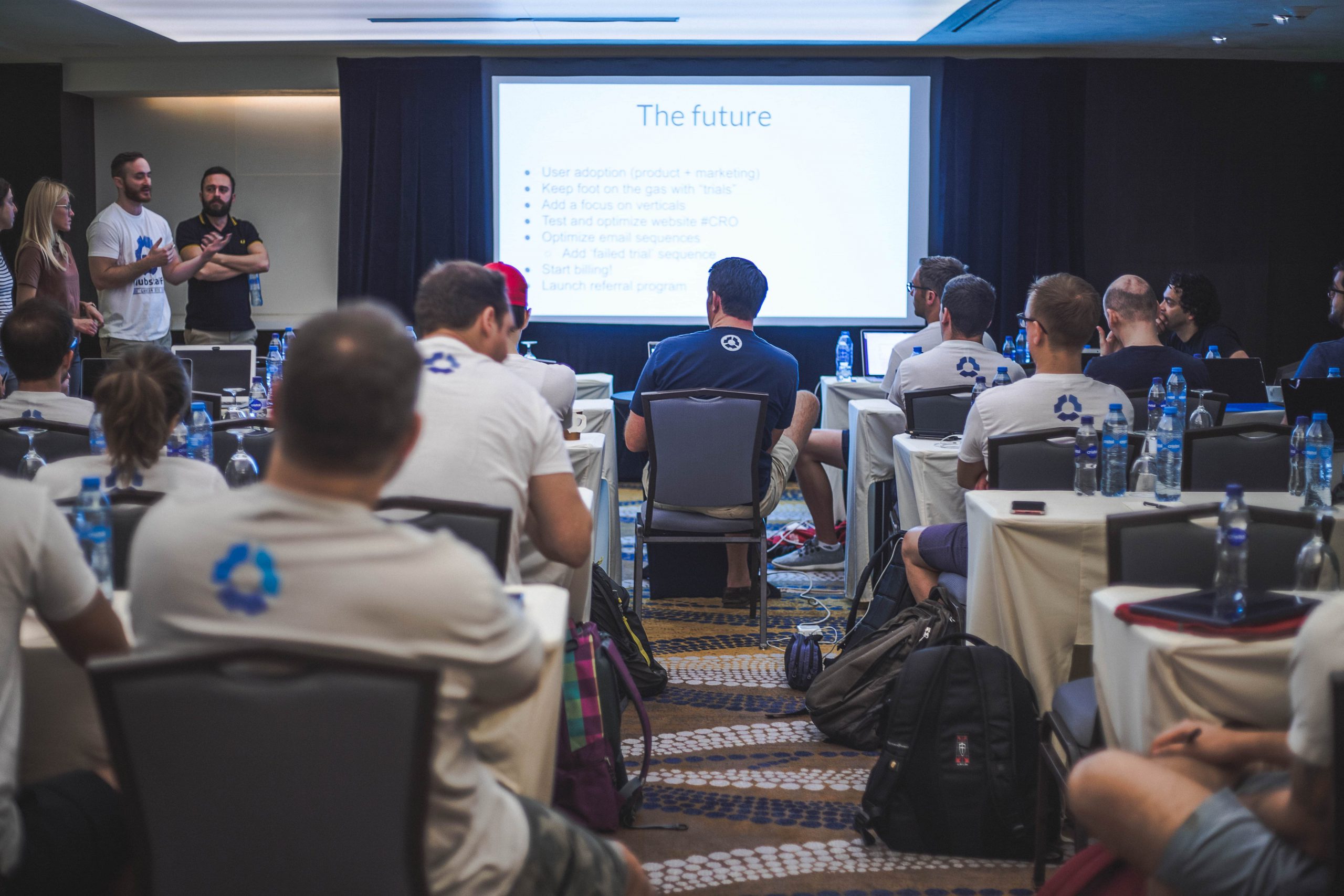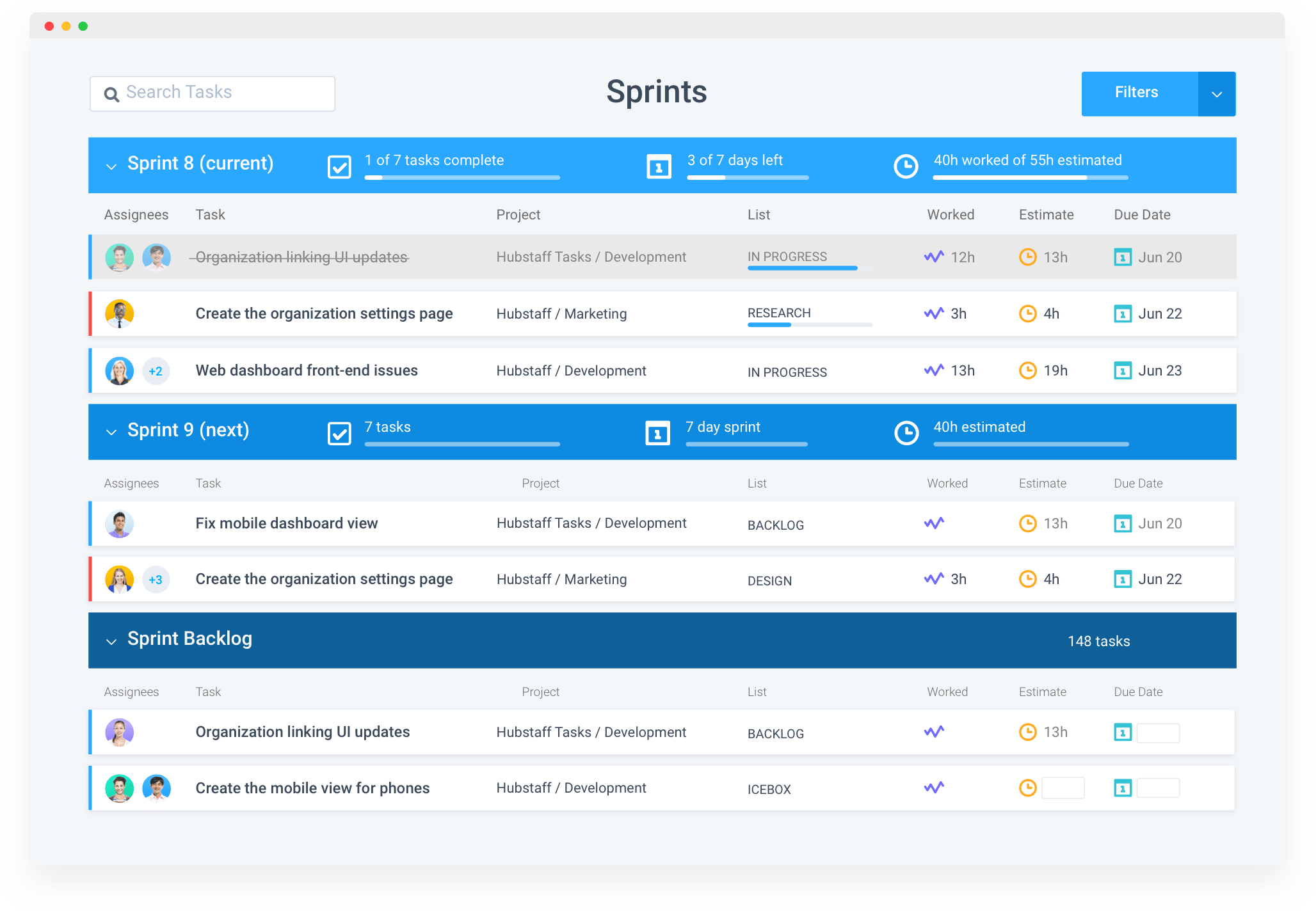
Hubstaff is productivity software that streamlines the process of managing remote teams. The app offers time tracking, activity monitoring, online timesheets, payroll, and invoicing capabilities that save time on admin work and get things done efficiently. It integrates with several other apps and runs on macOS, Windows, Linux, iOS, and Android.
Founded in 2012 in the US, Hubstaff made its journey through the nominee for The Best of Tech in Indiana in 2015 up to one of the world’s leading employee monitoring software today.
What makes this success so remarkable is the fact that Hubstaff is (and always was) a fully remote company. In this interview, Hubstaff’s CTO and co-founder Jared Brown shares insights on their remote work processes and culture.
YouTeam: Today Hubstaff is a well-known company. But if we could go back in time to the very beginning, how would you describe the core idea of your startup when you had just started? What problem were you trying to solve?
Jared: Hubstaff was born out of personal pain and a need to be free. My co-founder, Dave Nevogt, had started a remote business but immediately saw issues that made remote work challenging. Things like accurate time tracking, easy payments, and knowing what your team is working on when they’re not in one office were causing him headaches.
Hubstaff was started in order to make the difficult parts of remote work more streamlined, so you can focus on the work itself and all the flexibility it affords. For example, being able to structure your day, prioritizing what’s important to you, and not having to sit in traffic commuting to the office.
Today, we’ve grown the business beyond the platform for better remote work. Hubstaff supports a wide range of businesses with GPS and geofencing features for field teams, along with in-depth reporting for companies that want to improve their efficiency.
We’ve been a fully remote team from day one and are now over 60 members strong. The business is generating close to $10M in ARR.
YouTeam: Hubstaff was in the lucky minority of companies that the COVID-19 wave didn’t hit badly. Quite the opposite, in a recent interview, you mentioned that the number of companies signing up with Hubstaff has risen by three times. Do you still see these numbers, or was the increase temporary?
Jared: It’s unfortunate that a pandemic is a reason behind the increase in remote work. While we’re happy to see other businesses take on this practice, we wish it wasn’t because of this.
We hope that other businesses that have been forced to adapt to their team’s safety see the benefits and continue to offer flexible work environments.
As far as our business goes, we’re still seeing an increase in active subscriptions, but the initial wave of customers who were getting up and running as a remote team has slowed some.
Overall, business is still up from where it was. The need for this software is still very strong. This is because many companies are continuing to work remotely into 2021, including Slack and Google, meaning remote work software is still necessary.
When it comes to cancellations, we’ve heard from customers that they are returning to an office where they don’t usually track time, or, worse, customers are having to close their businesses. Other customers who return to their previous environments are still using Hubstaff because they find the team management aspect valuable.
YouTeam: It seems like remote work is becoming more and more relevant by the day. But for you at Hubstaff, remote was a set course from the very beginning. Do you remember how you made the decision to build a remote company? Despite all the hype around remote, we have heard it’s still taboo for most companies. Why do you think this is the case? What gave you the confidence to go this way?
Jared: To us, there’s no comparison when it comes to remote work. We learn from and support our talented team members all over the world. We have families that get more time together and we build tools that help teams like ours work better together.
It helps that we are able to hire from a global talent pool, at competitive hourly rates, and don’t have to spend money on overhead (offices or equipment). But most of all, working from home is a more distraction-free and efficient way to run our business. Being in one office wouldn’t allow for that.
It’s not if you should allow your team to work in a more flexible manner, but how? How can you structure your team and processes to embrace this freedom and increased productivity?
YouTeam: According to your website, Hubstaff has team members in 18 countries. How have you overcome difficulties like cultural differences (if there are any)? Do you think the company’s internal culture helps with that?
Jared: The practices we embrace to foster communication and connectedness help, including defaulting to video for calls and hosting monthly AMAs on our dedicated Slack channel. To get to know each other better, we also meet up for a retreat once a year in a different country. This year, however, we’ll host a virtual retreat.

With team members in different time zones, you don’t know when you’re going to get an answer to a question.
This initially looks like a disadvantage, but it quickly turns into a superpower.
The reason why is that if you ask the question over Slack or email, you most likely have to wait for an answer. That means that it may have been easier for you to just find the answer yourself. This leads to team members doing a better job of finding their own answers because it’s easier than waiting hours or a day to get an answer. And if they do ask the question but they don’t give enough information, they end up waiting that whole time for an answer but instead get a question from a confused recipient who needs more information or context around the question.
This leads to people being more detailed and explicit when asking their questions. Lastly, it means that you can’t force an interruption on another team member. That team member may be busy or in “focus mode” right now. They’ll get back to you when they come back up for air.
In an office environment, it is all too easy to run over and interrupt someone with a question and it’s the number one reason offices are so unproductive.
With team members in different time zones, there’s another problem: you don’t know when you’ll receive an answer to a question. While this initially seems like a disadvantage, it quickly turns into a superpower. Team members learn to ask more detailed and explicit questions or find answers on their own.
We also like to get referrals from our team when it comes to hiring, which can help others feel more at home. It’s a small thing, but we have a robust onboarding process that we follow with every hire to make sure they feel welcome from day one.
YouTeam: Could you tell us more about Hubstaff’s transparency policy? Where did it come from? Do policies like this and your open metrics policy help to motivate the team?
Jared: Clarity and communication are crucial for any team, which is why we prioritize transparency in our teams and within our tools. We believe transparency grants greater flexibility and better decision-making.
This is true for our apps, too. Hubstaff lets our customers keep working while also showing progress so that day-to-day tasks aren’t micromanaged. There’s less time wasted, better record-keeping, and more transparency overall.
YouTeam: How did you choose where to hire talent? Were you specifically targeting some countries for some roles?
Jared: No, we don’t target specific countries. Some positions require an overlap of a few hours with the Eastern time zone in the U.S., but we include that in the job description if so.
YouTeam: Many company leaders find time zone differences to be one of the most challenging aspects of working with remote teams. How do you approach this problem at Hubstaff? Let’s take your development team as an example. Do you all work in the same time zone?
Jared: We work asynchronously, which means we make sure anyone can pick up a task and run with it during their workday without waiting on others. We use our own Agile project management tool, Hubstaff Tasks, to make this happen. All of the information is in one task, which includes checklists, attachments, links to mockups and content docs, assignees, followers, and more.
We build our process out in a Kanban-style project board, with each column designating one step.
We also gather for weekly Sprint calls within our teams to discuss what’s being worked on this Sprint, any roadblocks, and what’s coming up next.

YouTeam: Do you think the remote work in a development team requires any additional skills from your employees? And via versa. What should a manager of the remote team know and do? Can you give some advice to other company leaders who are new in remote management since the pandemic?
Jared: Good time management is key here. We recommend to all of our team members that they only accept or schedule meetings during their morning. Then leave the afternoons blocked out for “focus mode.”
Otherwise what can happen is that a developer’s day gets carved up by meetings and interruptions throughout their day. For a developer, who needs at least 2-4 hours to get into a groove writing code, this will mean they don’t get to program on days they can’t work distraction-free for multiple hours at a time.
But I think this practice works well in an office environment, too. Basically, there’s not much a developer needs to do differently in a remote environment. The tools and best practices are the same. I think it’s just easier to excel at them in a remote environment. It’s too easy to give in to distractions in an office.
YouTeam: Do you use only Hubstaff tools for team management, or do you refer to some external solutions? Can you please tell us about both?
Jared: We really only use our own tools for team management. In addition to Hubstaff Tasks, every team member tracks their time with Hubstaff’s desktop, web, or mobile apps.
At the end of the week, the time each person tracks is used to calculate and automatically send payments. We use timesheet approvals and time off features to manage our team, as well.
The detailed reporting gives us insight into where we’re spending our time and where we need more resources to reach our quarterly goals.
YouTeam: As a platform for hiring remote developers, we at YouTeam are always curious about how recruitment in other companies works. Many companies are skeptical about hiring employees that they have never met in person, especially for tech roles. Do you have any strategies on how to overcome the possible risks of remote hiring that you could share with us?
Jared: We understand that. Often, when we’re interested in hiring, we do a paid test project so a potential candidate can see how we work and we can see how well they can handle a task they’ll be taking on as a team member.
These test projects typically only take 4-6 hours total to complete. We’re big advocates of doing these projects because it sends so many signals as to how proficient the developer is. Asking technical interview questions and having the candidate walk through their past jobs is great, and we do that, as well.
YouTeam: Hubstaff turns 10 next year. Have you already started summing up the results of this decade? How has the company, and your vision for it, changed over time?
Jared: We continue to evolve the product offerings and our vision for the company. But our mission hasn’t changed. We want to build the workforce management suite for distributed (remote) teams.
That is a much bigger goal than just building a great time tracking or desktop-based proof of work tool. It’s what has driven us to build Hubstaff Talent and Tasks. We have a lot more planned. So we’re really just getting started in fulfilling our mission.
YouTeam: If you weren’t 100% involved in Hubstaff, what would you do? Do you see any other problems you’d like to solve?
Jared: This is a tough question. Marc Andreessen has a good quote about software eating the world. It’s been doing it for three to four decades already, but it never ceases to amaze me all of the industries and use cases where software hasn’t already become the standard way of doing things. I’d look for other opportunities and markets where there is not yet an entrenched software solution or any software solution and run them through our startup test checklist to find the best one.
YouTeam: Thank you for sharing your experience with our readers and for making your impact on spreading remote work culture!




